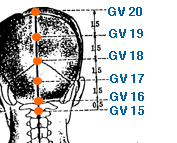GV 20 GV20 Hundred Convergences Bai Hui 百會 governing vessel 20 Governing Vessel 20 gv20
GV 20 GV20
GV 20 GV20
GV 20 Hundred Convergences - Bai Hui - 百會

Location
5 cun posterior to the AHL.
Associations
- Sea of Marrow Point (with GV 16)
- Intersecting Point of the Governing Vessel, Urinary Bladder, Gall Bladder, Triple Heater & Liver Channels
Actions
- Main point for headache, dizziness, eye pain and redness, irritability, hypertension from excess yang in the upper body, often occuring with patterns of excess Liver yang or Liver fire. Combine with lower body points such as LV 2, LV 3, KD 1, GB 34, GB 41.
- Main point for internal wind which has some overlapping indications with the above entry, for headaches, dizziness, visual dizziness, tinnitus, vertex pain, windstroke, seizures.
- Main point for prolapse, anal, uterine, vaginal; main point for hemorrhoids.
- Tong Ren/Tam Healing System: Used to effect the association area (related to emotions, memory, behavior), useful for low energy, yang energy imbalances, parkinson's, alzheimer's, motor control issues.
Relationships
Point Categories (1)
Nearby Points (1)
- UB 8 Declining Connection
Tong Ren Treatment Protocols (40)
- Tam Healing and Tong Ren Therapy for Abnormal Posture
- Tam Healing and Tong Ren Therapy for Acrocyanosis
- Tam Healing and Tong Ren Therapy for Athetosis
- Tam Healing and Tong Ren Therapy for Dizziness (Vertigo)
- Tam Healing and Tong Ren Therapy for Endometriosis
- Tam Healing and Tong Ren Therapy for Headaches
- Tam Healing and Tong Ren Therapy for Herniated Disc
- Tam Healing and Tong Ren Therapy for Reflex Sympathetic Dystrophy (RSD)
- Tam Healing and Tong Ren Therapy for Restless Legs Syndrome (RLS)
- Tam Healing and Tong Ren Therapy for Scoliosis
- Tam Healing and Tong Ren Therapy for Spinal Stenosis
- Tam Healing and Tong Ren Therapy for Tremor
- Tam Healing and Tong Ren Therapy for Abnormal Body Temperature
- Tam Healing and Tong Ren Therapy for Alzheimer's Disease
- Tam Healing and Tong Ren Therapy for Amyotrophic Lateral Sclerosis (ALS)
- Tam Healing and Tong Ren Therapy for Ankylosing Spondylitis
- Tam Healing and Tong Ren Therapy for Autism
- Tam Healing and Tong Ren Therapy for Bone Spur
- Tam Healing and Tong Ren Therapy for Cerebral Palsy
- Tam Healing and Tong Ren Therapy for Common Cold
- Tam Healing and Tong Ren Therapy for Dementia
- Tam Healing and Tong Ren Therapy for Edema
- Tam Healing and Tong Ren Therapy for Epilepsy (Seizure)
- Tam Healing and Tong Ren Therapy for Fibromyalgia (CFS)
- Tam Healing and Tong Ren Therapy for Hair Loss
- Tam Healing and Tong Ren Therapy for Hypertension (High Blood Pressure)
- Tam Healing and Tong Ren Therapy for Knee Pain
- Tam Healing and Tong Ren Therapy for Leg Cramps
- Tam Healing and Tong Ren Therapy for Lyme Disease
- Tam Healing and Tong Ren Therapy for Meniere's Disease
- Tam Healing and Tong Ren Therapy for Migraines
- Tam Healing and Tong Ren Therapy for Multiple System Atrophy
- Tam Healing and Tong Ren Therapy for Psoriasis
- Tam Healing and Tong Ren Therapy for Sciatica
- Tam Healing and Tong Ren Therapy for Scleroderma
- Tam Healing and Tong Ren Therapy for Stroke
- Tam Healing and Tong Ren Therapy for Tourette Syndrome
- Tam Healing and Tong Ren Therapy for Uterine Prolapse
- Tam Healing and Tong Ren Therapy for Vertigo
- Tam Healing and Tong Ren Therapy for Whiplash
Related Blog Posts (18)
- Acupuncture for Insomnia - Mechanisms Explored
- Acupuncture for Spinal Cord Injury
- Acupuncture for Tinnitus - Study Shows Positive Results
- Acupuncture Injections With Enercel May Help ALS (Lou Gehrig's Disease)
- Acupuncture Outperforms Prozac for Fibromyalgia Treatment
- Acupuncture Treatment Basics For Male and Female Fertility Issues
- Acupuncture Treatment Helpful for Trigeminal Neuralgia
- Anxiety Improved By Acupuncture And Electroacupuncture - With or Without Pharmaceuticals
- Autism Treatments - Brain Inflammation and the Role of Sky Window Acupuncture Points from the Tam Healing System
- Electro-Acupuncture May Aid Substances To Cross Blood-Brain Barrier
- Electroacupuncture Found More Effective Than Nimodipine for Mild Cognitive Impairment
- Head, Scalp and Shoulder Acupressure Points
- Randomized Controlled Clinical Trial Finds Acupuncture Superior to Medication for Treatment of Migraines
- Sometimes Simple Is Better - Randomized Study Finds Acupressure Improves Cognition
- Stroke Rehabilitation with Acupuncture, Tuina, and Tong Ren Therapy
- Study Finds Acupuncture Effective For Premature Ovarian Failure
- Tong Ren Therapy for Cancer and other Ailments - General Questions and Comparisons
- Why Does Acupuncture Help Depression? - Researchers Find It Regulates Zinc and Copper Levels
Related Research Synopses (2)